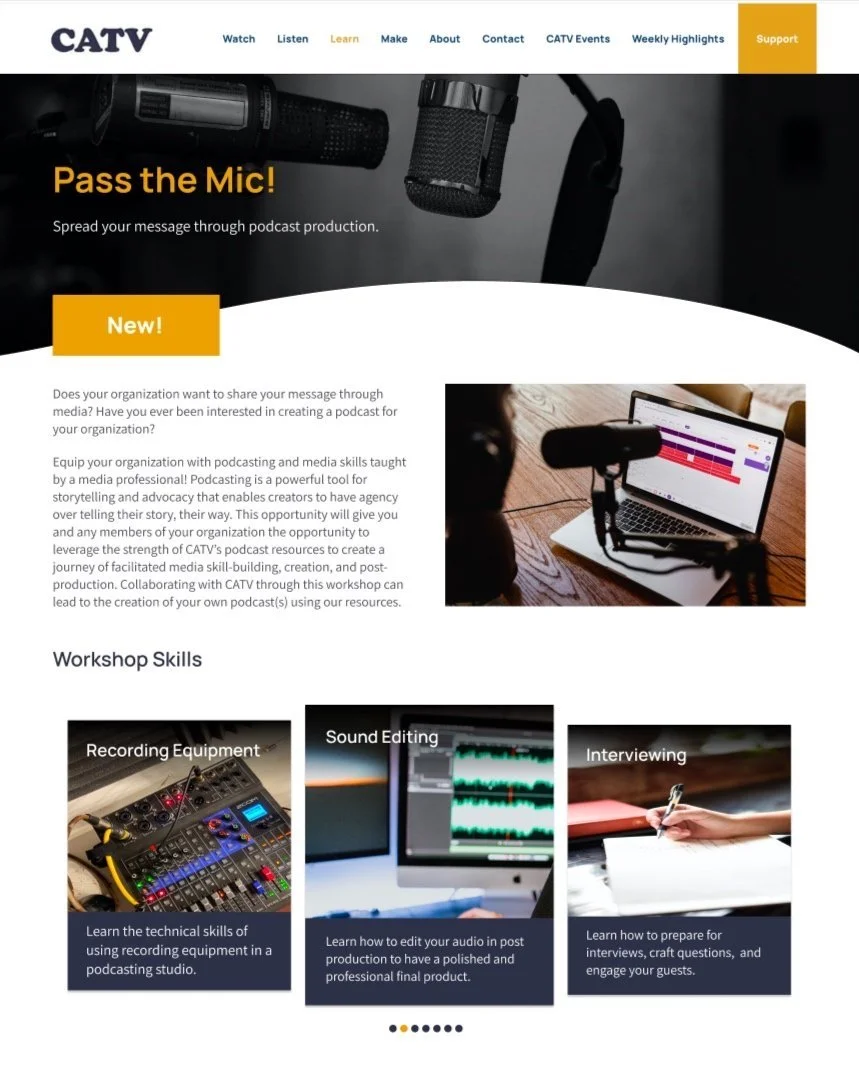Pass the Mic!
Designing a new initiative to increase media agency and engage new creators from underrepresented and unheard groups in New Hampshire and Vermont.
This project was through the Senior Design Challenge, an interdisciplinary capstone course for Human Centered Design minors at Dartmouth College.
My team of four designers worked with Community Access Television (CATV)*, a local media organization, to engage new creators from underrepresented or unheard groups in the Upper Valley of New Hampshire and Vermont.
*CATV has since rebranded to “JAM”
Background
CATV is a television network and non-profit media organization, with a mission to “provide a platform to all residents where they can debate local issues, showcase artistic expression and celebrate school and community happenings. CATV also delivers independent access to local political issues through the recording of government meetings.” (CATV 2022)
Research
Our primary research goals were:
Understand who is underrepresented in the Upper Valley and why.
Finding out how said underrepresented people currently interact with media.
Understanding how CATV interacts with the communities it serves.
Better understand Upper Valley demographics.
In order to better understand the dynamics of the Upper Valley and why certain groups are being underrepresented in media, we identified the following stakeholder groups to conduct user interviews with.
I facilitated 25 interviews and engaged in experiential observation at CATV events. We also sent out a survey to community members and CATV viewers to gather general data about media consumption in the Upper Valley.
Insights
The primary insights that informed our solution were:
The Upper Valley is characterized by its “tight-knit community” that relies on interpersonal relationships. Those who identify outside of these niche circles (such as BIPOC and queer folks) are less likely to engage with community-based organizations such as CATV.
Participating in local media opens people with marginalized identities up to a heightened level of exposure which can threaten their safety.
People with marginalized identities in the Upper Valley need the scaffolding to build creative confidence in media to have agency over how their stories are told.
Because CATV works to serve such a vast audience across different mediums, CATV ends up spreading itself too thin, and ultimately compromising how effectively it serves any one group.
Focus Audience
We narrowed in on affinity organizations, which are established collectives of people who share an identity, lived experience, and/or mission.
Organizations can provide the support necessary to protect representatives that participate in content creation and media coverage and can serve as a vehicle for partnership with CATV, Our hope was to decrease the chances for tokenization and increase the levels of community support as underrepresented groups engage in local media. Some groups we worked with were:
Ideation
My team brainstormed a variety of ideas to address the insights we found.
Our initial ideas focused on utilizing CATV’s existing resources, increasing media agency for minority groups, and examining CATV’s own relationship with underrepresented groups.
From our discussion, we decided to combine two of our ideas, and refined our strategy based on the team’s feedback.
I then facilitated a co-creation session with CATV staff to narrow in on a strategy. We presented three initial ideas to five members of the CATV staff and used the following prompts to discuss the ideas:
How might this idea fail?
How might we overcome this potential failure?
Other questions/thoughts/builds on this idea?
Solution
“Pass the Mic!” is a new podcasting workshop series for affinity organizations.
We designed a new podcasting workshop series for affinity organizations, focused specifically on safety, storytelling, and media agency for underrepresented communities.
We found the audio-only format of podcasts allows for additional anonymity and better ensures the safety of underrepresented groups. CATV also has a professional podcasting studio and runs media workshops, so this would integrate easily into their existing services.
Prototyping
I facilitated a prototype of our solution with a local affinity organization and the podcasting instructor.
Together with a professional podcasting expert, my team and I created a sample curriculum for the workshop. We tested the curriculum in a sample workshop session, where members of the affinity organization learned key podcasting skills and got to record a short podcast clip. We followed up with an exit interview and survey questions about the experience and received valuable feedback, which we used to tweak our final curriculum. Following the workshop, the affinity organization started a weekly podcast streamed on CATV.
Deliverables
We created a curriculum for the workshop series with the instructor, an outreach template to help CATV more effectively reach affinity organizations, and materials for participants, such as an equipment list and a “who’s who at CATV” sheet.
I also created a website for the initiative where groups can find information and sign up for the workshop. I designed several iterations in Figma, and conducted AB testing with users, before creating a working page on CATV’s existing website.
Our project with CATV ended in June 2022. Our handoff documents and the resources we created were designed to ensure a smooth transition and the proper scaffolding for CATV to further implement our initiative.
















